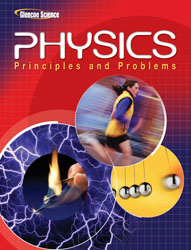1 The formula represents the period of a pendulum, T. What is the period of a 3.5 m-long pendulum on Earth?
<a onClick="window.open('/olcweb/cgi/pluginpop.cgi?it=jpg::::/sites/dl/free/0078807220/617922/mh.JPG','popWin', 'width=NaN,height=NaN,resizable,scrollbars');" href="#"><img valign="absmiddle" height="16" width="16" border="0" src="/olcweb/styles/shared/linkicons/image.gif"> (1.0K)</a> A) 3.2 s B) 4.6 s C) 3.8 s D) 1.4 s 2 In the figure below, if the spring's constant is 20.0 N/m and x has a value of 0.25 m, what is m equal to?
<a onClick="window.open('/olcweb/cgi/pluginpop.cgi?it=jpg::::/sites/dl/free/0078807220/617922/mi.JPG','popWin', 'width=NaN,height=NaN,resizable,scrollbars');" href="#"><img valign="absmiddle" height="16" width="16" border="0" src="/olcweb/styles/shared/linkicons/image.gif"> (9.0K)</a> A) 0.06 kg B) 0.63 kg C) 0.51 kg D) 5.0 kg 3 In the figure below, if you doubled the mass of the pendulum, what effect, if any, would it have on its period?
<a onClick="window.open('/olcweb/cgi/pluginpop.cgi?it=jpg::::/sites/dl/free/0078807220/617922/mk.JPG','popWin', 'width=NaN,height=NaN,resizable,scrollbars');" href="#"><img valign="absmiddle" height="16" width="16" border="0" src="/olcweb/styles/shared/linkicons/image.gif"> (6.0K)</a> A) The new period would be half the old period. B) The new period would be the old period, divided by the square root of two. C) The new period would be the old period, times the square root of two. D) It would have no effect. 4 In the figure below, if the scale of the graph is 1 block = 10 N on the vertical axis and one block = 2 cm on the horizontal axis, what is the spring constant?
<a onClick="window.open('/olcweb/cgi/pluginpop.cgi?it=jpg::::/sites/dl/free/0078807220/617922/mj.JPG','popWin', 'width=NaN,height=NaN,resizable,scrollbars');" href="#"><img valign="absmiddle" height="16" width="16" border="0" src="/olcweb/styles/shared/linkicons/image.gif"> (6.0K)</a> A) 500 N/m B) 250 N/m C) 5 N/m D) 20 N/m 5 In the figure below, if you quadrupled the length of the string, what effect, if any, would it have on its period?
<a onClick="window.open('/olcweb/cgi/pluginpop.cgi?it=jpg::::/sites/dl/free/0078807220/617922/mk.JPG','popWin', 'width=NaN,height=NaN,resizable,scrollbars');" href="#"><img valign="absmiddle" height="16" width="16" border="0" src="/olcweb/styles/shared/linkicons/image.gif"> (6.0K)</a> A) The period would be halved. B) The period would be doubled. C) It would have no effect. D) The period would be quadrupled. 6 A) fluctuates B) remains the same C) decreases D) increases 7 A) a gas B) a solid C) a medium D) a vacuum 8 A) f = 1/T B) 1/f = 1/T C) f = 2T D) f = T 9 In the figure below, how much time elapses between pictures a and c?
<a onClick="window.open('/olcweb/cgi/pluginpop.cgi?it=jpg::::/sites/dl/free/0078807220/617922/ml.JPG','popWin', 'width=NaN,height=NaN,resizable,scrollbars');" href="#"><img valign="absmiddle" height="16" width="16" border="0" src="/olcweb/styles/shared/linkicons/image.gif"> (24.0K)</a> A) 25 s B) 0.02 s C) 0.04 s D) Not enough information is given to answer this question. 10 A) 20 m/s B) 0.2 m/s C) 5 m/s D) 2 m/s 11 A) speed B) frequency C) period D) amplitude 12 A) matter B) particles C) energy D) heat 13 A) both parallel and perpendicular B) in a circular motion relative C) parallel D) perpendicular 14 A) wave pulse B) surface wave C) compressional wave D) continuous wave 15 In Figure 14-14, how do the frequencies of the waves in pictures a and c compare?
<a onClick="window.open('/olcweb/cgi/pluginpop.cgi?it=jpg::::/sites/dl/free/0078807220/617922/mm.JPG','popWin', 'width=NaN,height=NaN,resizable,scrollbars');" href="#"><img valign="absmiddle" height="16" width="16" border="0" src="/olcweb/styles/shared/linkicons/image.gif"> (20.0K)</a> A) a's frequency is twice c's. B) a's frequency is four times c's. C) a's frequency is half of c's. D) a's frequency is one-quarter of c's. 16 A) the starting point B) the midpoint C) the low point D) the high point 17 A) surface B) longitudinal C) compressional wave D) transverse 18 A) frequency B) medium C) energy D) amplitude 19 A) incidence B) reflection C) normal D) angle 20 A) less dense B) softer C) more gaseous D) more dense 21 A) waves from different mediums can combine to form a new wave B) the energy of a wave depends on its position C) waves can never combine D) two or more waves can combine to form a new wave 22 A) constructive interference B) consonance C) dissidence D) destructive interference 23 A) increases B) decreases C) interferes with itself D) becomes negative 24 A) moving very fast B) fluctuating C) standing still D) moving very slowly 25 A) changed from compressional to transverse B) inverted C) amplified D) reduced to zero 26 A) A node B) A period C) A crest D) An antinode 27 A) a different angle from which it struck the surface B) an angle of zero C) the same angle at which it struck the surface D) a right angle to the surface 28 A) Refraction B) Diffusion C) Diffraction D) Reflection 29 A) incident B) surface C) transverse D) reflected














